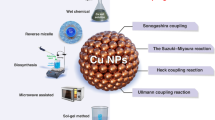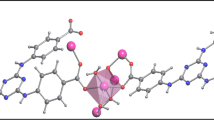Abstract
The compound ReMn(CO)8 (μ-MeC2NMe2),2 was obtained in 11% yield by the decarbonylation of ReMn(CO)10 with Me3NO followed by reaction MeC2NMe2. Compound2 will add one equivalent of MeC2NMe2 at 25°C to yield the mixed metal complex ReMn(CO)7 [μ-C(Me) C(NMe2) C(NMe2) C(Me)],3 in 7% yield. Compounds2 and3 were characterized by IR,1H NMR, and single crystal x-ray diffraction analyses. Compound2 exists as two isomers. Each isomer contains an asymmetric bridging ynamine ligand. The principal isomer has the amine-substituted carbon atom coordinated to the manganese atom. The minor isomer has the amine-substituted carbon atom coordinated to the rhenium atom. In compound3 the two ynamines have been coupled in a head-to-head fashion to produce a ferrole-like structure in which the coupled ligands are π-bonded to the manganese atom. Extended Hückel molecular orbital calculations were performed on the parent complex Re2(CO)8 (μ-MeC2NMe2),1 to try to understand the reasons for the preferred asymmetric coordination of the ynamine ligand in1 and2. It was found that the asymmetric coordination permits a strong stabilizing interaction between the one of the π* orbitals of the ligand and the metallic orbital that is principally responsible for the formation of the metal-metal bond. Crystal Data: for2: space group=P21/c,a=9.740(1)Å,b=11.293(2)Å,c=15.483(3)Å, β=97.46(1)°,Z=4, 1876 reflections,R=0.026; for3: space group=Pca21,a=17.541(2)Å,b=8.441(1)Å,c=14.033(3)Å,Z=4, 1335 reflections,R=0.022.
Similar content being viewed by others
References
Z. Nomikou, J. F. Halet, R. Hoffmann, J. T. Tanner, and R. D. Adams (1990).Organometallics 9, 588.
E. Cabrera, J. C. Daran, Y. Jeannin, and O. Kristiansson, (1986).J. Organomet. Chem. 310, 367;
F. Muller, G. van Koten, M. J. Kraakman, K. Vrieze, D. Heijdenrijk, and M. C. Zoutberg (1989).Organometallics 8, 1331;
R. D. Adams and J. T. Tanner (1989).Organometallics 8, 563.
R. D. Adams and J. T. Tanner (1988).Organometallics 7, 2241;
A. J. Deeming, S. E. Kabir, D. Nuel, and N. I. Powell (1989).Organometallics 8, 717.
R. D. Adams, G. Chen, J. T. Tanner, and J. Yin (1990).Organometallics 9, 595.
R. D. Adams, G. Chen J. T. Tanner, and J. Yin, (1990).Organometallics 9, 1240;
R. D. Adams, G. Chen, S. Sun, J. T. Tanner, and T. A. Wolfe (1990).Organometallics 9, 251.
R. D. Adams, G. Chen, J. T. Tanner, and J. Yin (1990).Organometallics 9, 1523.
R. D. Adams, G. Chen, and J. T. Tanner, (1990).Organometallics 9, 1530.
R. D. Adams, G. Chen, and J. Yin (1991).Organometallics 10, 1279.
A. N. Nesmeyanov, K. N. Anisimov, H. Ye. Kolobova, and I. S. Kolomnikov (1963).Izv. Akad. Nauk SSSR, Otd. Khim. Naud 194.
L. Brandsma,Preparative Acetylenic Chemistry (Elsevier, Amsterdam, 1971), p. 146.
R. Hoffmann (1963).J. Chem. Phys. 39, 1397.
J. H. Ammeter, H.-B. Bürgi, J. Thibeault, and R. Hoffmann, (1978).J. Am. Chem. Soc. 100, 3686.
International Tables for X-ray Crystallography (Kynoch Press, Birmingham, England, 1975), Vol. IV, Table 2.2B, pp. 99–101; Table 2.3.1, pp. 149–150.
D. M. Hoffmann, R. Hoffmann, and C. R. Fisel (1982).J. Am. Chem. Soc. 104, 3858 (and references therein).
K. J. Ahmed, M. H. Chisholm, K. Folting, and J. C. Huffman (1986).Organometallics 5, 2171.
E. Valencia, B. D. Santarsiero, S. J. Gelb, A. L. Rheingold, and J. M. Mayer (1987).J. Am. Chem. Soc. 109, 6896;
F. A. Cotton and M. Shang (1990).Inorg. Chem. 29, 508.
M. J. Calhorda, and R. Hoffmann (1986).Organometallics 5, 2187;
F. A. Cotton and X. Feng (1990).Inorg. Chem. 29, 3187.
F. A. Cotton, J. D. Jamerson, and B. R. Stults (1976).J. Am. Chem. Soc. 98, 1774.
M. Elian and R. Hoffmann (1975).Inorg. Chem. 14, 1058;
T. A. Albright, R. Hoffmann, J. C. Thibeault, and D. L. Thorn (1979).J. Am. Chem. Soc. 101, 3801.
I. S. Butler and J. F. Harrod,Inorganic Chemistry: Principles and Applications (The Benjamin/Cummings Publishing Company, 1989), p. 61.
D. E. Fjare and W. L. Gladfelter (1984).J. Am. Chem. Soc. 106, 4799;
S. Harris, M. L. Blohm, and W. L. Gladfelter (1989).Inorg. Chem. 28, 2290.
Author information
Authors and Affiliations
Rights and permissions
About this article
Cite this article
Adams, R.D., Chen, G., Chen, L. et al. Clusters containing ynamine ligands. 4. The synthesis and characterizations of ReMn(CO)8 [μ-MeC2NMe2] and ReMn(CO)7 [μ-MeCC(NMe2)C(NMe2)CMe] and the development of a bonding model for the coordination of ynamines to M2(CO)8 clusters. J Clust Sci 2, 83–103 (1991). https://doi.org/10.1007/BF00702950
Received:
Issue Date:
DOI: https://doi.org/10.1007/BF00702950




